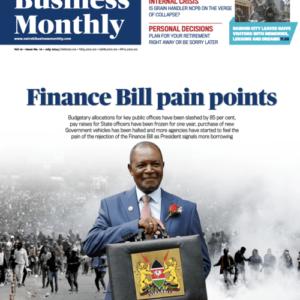Whereas increased production is one avenue to pursue, we must also diversify our production to cover crops such as soybeans and yellow maize
By Joseph Choge
The short rains are here with us, and with it, an opportunity to sow the seeds for a bounty harvest around November this year.
Whereas El Niño preps appear to be all the rave, recently, my mind couldn’t help but reminisce on the good old days growing up in the village and the mixed feelings accompanying the onset of the rains.
Download Nairobi Business Monthly Latest Edition
We never loved the rains that much and considered it an unnecessary nuisance past the first day of rainfall. See, in my neck of the woods, we didn’t have the luxury of singing “Rain, Rain, Go Away”, that popular English pre-school rhyme. For us, the motivation for rain, rain, go away wasn’t for kids to come out and play. It was to save “little Choge” from hard work and related challenges that came with rain.
In my village, the onset of rains meant the start of what project managers call a rapid results period. This was when we endured back-breaking field preparation and planting sessions.
Looking back almost four decades later, we truly had a fantastic childhood that prepared us for the challenges of modern-day living. I am glad we endured the experiences that have significantly shaped our lives today.
Sadly, we may have taken a few steps back as agricultural production is dwindling compared to population growth. Lower agricultural production effectively leads to food insecurity and food inflation.
In my current role at Kenya’s milling enterprise, Unga Group, I am filled with sadness on the few occasions when I have to join my colleagues in approving purchase orders for imported raw materials such as maize and wheat, among other cereals and pulses that underpin the Unga brand.
Had we kept the agricultural pace we maintained in my primary school days, and with the technological, mechanization and crop husbandry advances we’ve made over the years, there would be no reason to import our staple foods.
According to the Kenya Economic Survey 2023, the quantity of maize imported rose to 793.8 thousand metric tonnes in 2022 against a local production base of 150.8 thousand metric tonnes. The volume of wheat production in 2022 stood at 270.7 thousand tonnes in 2022, while wheat imports hovered at around 1.7 million tonnes last year.
This means we are importing more than five times the value of any staple produce we eat. Forget about Wheat and Maize; most of the rice you eat is more likely imported from Pakistan, and the same is true for the sugar you consumed this morning.
I get very excited when I see government strategies focusing on agricultural transformation. Kenya has significant arable land resources, and this wanton importation of staple foods must be contained by resetting and retooling our agricultural production endeavours.
Whereas increased production is one avenue to pursue, we must also diversify our production to cover crops such as soybeans and Yellow Maize. Growing these crops would provide a good foundation for food security ideals by reducing the competition for the scarce and expensive white maize for human and animal feed production.
In animal feed production, substituting yellow maize and soya beans instead of white maize in its various forms would effectively bring down the cost of animal feeds and positively impact efforts to lower the cost of maize flour. The reason is that the white maize currently consumed by animal feed manufacturers would now be accessible to human nutrition manufacturers.
The importation of yellow maize will not only stabilize the maize market but also help to reduce food prices and animal feed prices.
One of the key advantages of yellow maize is its versatility. Unlike white maize, primarily used for human consumption, yellow maize has multiple uses, including animal feed and industrial other purposes. This versatility creates a buffer against price fluctuations in the food market.
When maize prices for human consumption surge, farmers can divert their yellow maize to the animal feed or industrial sectors, stabilizing the overall market.
Yellow Maize is rich in essential nutrients like vitamin A and beta-carotene, which are crucial for maintaining a healthy population. By encouraging its consumption, the government can address malnutrition issues while reducing the pressure on white maize prices.
Interestingly, yellow maize utilization is low because it is regarded as a poor man’s crop, associated with food aid and reserved as livestock feed. This negative perception can be changed through educational campaigns on its nutritional value to enhance local production and encourage social acceptability.
Finally, to fully realize the potential of yellow maize in achieving price stability, the government needs to invest in research and development, providing farmers with improved yellow maize varieties that are both high-yielding and disease-resistant.
As the rains set in, have yourself a reflective day and week ahead on how we can reimagine food production and agricultural transformation in Kenya. We all have a role to play.
Writer is the Group Managing Director at Unga Group PLC



